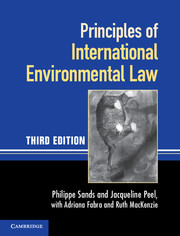Book contents
- Frontmatter
- Contents
- Foreword
- Preface and acknowledgments to the first edition
- Preface and acknowledgments to the second edition
- Preface and acknowledgments to the third edition
- Table of cases
- Table of treaties and other international instruments
- Abbreviations
- Part I The legal and institutional framework
- Part II Principles and rules establishing standards
- Part III Techniques for implementing international principles and rules
- 14 Environmental impact assessment
- 15 Environmental information
- 16 Financial resources, technology transfer and intellectual property
- 17 Liability for environmental damage
- Part IV Linkage of international environmental law and other areas of international law
- Index
- References
14 - Environmental impact assessment
from Part III - Techniques for implementing international principles and rules
Published online by Cambridge University Press: 05 June 2012
- Frontmatter
- Contents
- Foreword
- Preface and acknowledgments to the first edition
- Preface and acknowledgments to the second edition
- Preface and acknowledgments to the third edition
- Table of cases
- Table of treaties and other international instruments
- Abbreviations
- Part I The legal and institutional framework
- Part II Principles and rules establishing standards
- Part III Techniques for implementing international principles and rules
- 14 Environmental impact assessment
- 15 Environmental information
- 16 Financial resources, technology transfer and intellectual property
- 17 Liability for environmental damage
- Part IV Linkage of international environmental law and other areas of international law
- Index
- References
Summary
INTRODUCTION
Environmental impact assessments emerged internationally after the 1972 Stockholm Conference and are now an established international and domestic legal technique for integrating environmental considerations into socio-economic development and decision-making processes. An environmental impact assessment (EIA) describes a process that produces a written statement to be used to guide decision-making, with several related functions. First, it should provide decision-makers with information on the environmental consequences of proposed activities and, in some cases, programmes and policies, and their alternatives. Second, it requires decisions to be influenced by that information. And, third, it provides a mechanism for ensuring the participation of potentially affected persons in the decision-making process.
Since environmental impact assessments were first established in the domestic law of the United States under the 1969 National Environmental Policy Act, they have been progressively adopted in a very large number of national legal systems. Internationally, environmental impact assessments are required under numerous international conventions, in the requirements of various multilateral development banks, and in various non-binding instruments adopted at the regional and global levels. Principle 17 of the Rio Declaration states that:
environmental impact assessment, as a national instrument, shall be undertaken for proposed activities that are likely to have a significant adverse impact on the environment and are subject to a decision of a competent national authority.
- Type
- Chapter
- Information
- Principles of International Environmental Law , pp. 601 - 623Publisher: Cambridge University PressPrint publication year: 2012



